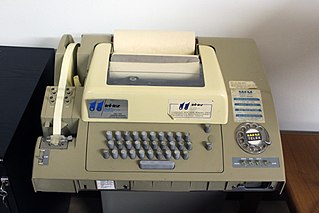The station, which took its nickname from its distinctive interval signal, began broadcasting in the early 1970s. It would broadcast daily, starting at 18:00UTC on 3.258 MHz, and continuing to broadcast a message every 30 minutes until 23:30UTC. [2] The broadcasts would start with a taped interval signal of chimes from a Church bell or clock tower, which was over the life of the station. Over the years that this tape was used for the interval signal, the tape wore and stretched, distorting the sound of the bells used. [1] On the hour or half-hour, a recorded female voice, created from a speech synthesised "Sprach-Morse Generator", would alert the intended recipients of the message, and give them the amount of five-figure groups of numbers in their message. Each recipient would then receive their message, prior to the chimes sounding one more time. [3] The station would also broadcast messages on Saturday morning, at 10:00UTC on 5.410 MHz. These messages were suspected to be sent to intelligence agents within the Western Bloc, to be decoded using a one-time pad.
In 1989, with the Peaceful Revolution leading to the eventual unification with West Germany in November 1990, the station's output became less consistent and scheduled, being heard only once a week on occasion. [1]
The station ceased to operate in May 1990, with its last broadcast taking place on 9 May. Curiously, the last message departs from the usual structure of the station, with a live male announcer introducing a song, and a group of possibly drunk males singing the German children's song "Alle meine Entchen [ de ]" (All My Ducklings) [3]

Electrical telegraphy is a point-to-point text messaging system, primarily used from the 1840s until the late 20th century. It was the first electrical telecommunications system and the most widely used of a number of early messaging systems called telegraphs, that were devised to send text messages more quickly than physically carrying them. Electrical telegraphy can be considered the first example of electrical engineering.

Morse code is a telecommunications method which encodes text characters as standardized sequences of two different signal durations, called dots and dashes, or dits and dahs. Morse code is named after Samuel Morse, one of the early developers of the system adopted for electrical telegraphy.

In cryptography, the one-time pad (OTP) is an encryption technique that cannot be cracked, but requires the use of a single-use pre-shared key that is larger than or equal to the size of the message being sent. In this technique, a plaintext is paired with a random secret key. Then, each bit or character of the plaintext is encrypted by combining it with the corresponding bit or character from the pad using modular addition.

Radioteletype (RTTY) is a telecommunications system consisting originally of two or more electromechanical teleprinters in different locations connected by radio rather than a wired link. Radioteletype evolved from earlier landline teleprinter operations that began in the mid-1800s. The US Navy Department successfully tested printing telegraphy between an airplane and ground radio station in 1922. Later that year, the Radio Corporation of America successfully tested printing telegraphy via their Chatham, Massachusetts, radio station to the R.M.S. Majestic. Commercial RTTY systems were in active service between San Francisco and Honolulu as early as April 1932 and between San Francisco and New York City by 1934. The US military used radioteletype in the 1930s and expanded this usage during World War II. From the 1980s, teleprinters were replaced by personal computers (PCs) running software to emulate teleprinters.

A teleprinter is an electromechanical device that can be used to send and receive typed messages through various communications channels, in both point-to-point and point-to-multipoint configurations.

The BBC World Service is an international broadcaster owned and operated by the BBC. It is the world's largest external broadcaster in terms of reception area, language selection and audience reach. It broadcasts radio news, speech and discussions in more than 40 languages to many parts of the world on analogue and digital shortwave platforms, internet streaming, podcasting, satellite, DAB, FM and MW relays. In 2024, the World Service reached an average of 450 million people a week. In November 2016, the BBC announced that it would start broadcasting in additional languages including Amharic and Igbo, in its biggest expansion since the 1940s.

The Emergency Broadcast System (EBS), sometimes called the Emergency Action Notification System (EANS), was an emergency warning system used in the United States. It was the most commonly used, along with the Emergency Override system. It replaced the previous CONELRAD system and was used from 1963 to 1997, at which point it was replaced by the Emergency Alert System.
A numbers station is a shortwave radio station characterized by broadcasts of formatted numbers, which are believed to be addressed to intelligence officers operating in foreign countries. Most identified stations use speech synthesis to vocalize numbers, although digital modes such as phase-shift keying and frequency-shift keying, as well as Morse code transmissions, are not uncommon. Most stations have set time schedules, or schedule patterns; however, some appear to have no discernible pattern and broadcast at random times. Stations may have set frequencies in the high-frequency band.

A radiotelephone, abbreviated RT, is a radio communication system for conducting a conversation; radiotelephony means telephony by radio. It is in contrast to radiotelegraphy, which is radio transmission of telegrams (messages), or television, transmission of moving pictures and sound. The term is related to radio broadcasting, which transmit audio one way to listeners. Radiotelephony refers specifically to two-way radio systems for bidirectional person-to-person voice communication between separated users, such as CB radio or marine radio. In spite of the name, radiotelephony systems are not necessarily connected to or have anything to do with the telephone network, and in some radio services, including GMRS, interconnection is prohibited.
CHU is the call sign of a shortwave time signal radio station operated by the Institute for National Measurement Standards of the National Research Council. CHU's signal is used for continuous dissemination of official Canadian government time signals, derived from atomic clocks.

A speaking clock or talking clock is a live or recorded human voice service, usually accessed by telephone, that gives the correct time. The first telephone speaking clock service was introduced in France, in association with the Paris Observatory, on 14 February 1933.

U-matic or 3⁄4-inch Type E Helical Scan or SMPTE E is an analogue recording videocassette format first shown by Sony in prototype in October 1969, and introduced to the market in September 1971. It was among the first video formats to contain the videotape inside a cassette, as opposed to the various reel-to-reel or open-reel formats of the time. The videotape is 3⁄4 in (19 mm) wide, so the format is often known as "three-quarter-inch" or simply "three-quarter", compared to open reel videotape formats in use, such as 1 in (25 mm) type C videotape and 2 in (51 mm) quadruplex videotape.

Charles Emory Apgar was an American business executive and amateur radio operator. He is known for making early recordings of radio transmissions at the start of World War I. The recordings that he made of a wireless telegraphy station owned by a German Empire-based company operating from the United States were used to expose an espionage ring. They provided evidence of clandestine messages being sent in violation of a prohibition intended to maintain United States neutrality. This proof of illicit operation led to the government seizing control of the facility to stop the activity. Apgar's efforts received extensive coverage in newspapers and technical science magazines at the time. His contributions were praised by government investigators. Publications continued to remark on his work many years later.
The Conet Project: Recordings of Shortwave Numbers Stations is a four- CD set of recordings of numbers stations and noise stations released by Irdial-Discs beginning in 1997. Numbers stations are shortwave radio stations believed to be operated by government agencies to communicate with deployed spies. The collection of recordings is primarily the work of Irdial-Discs founder Akin Fernandez, who began recording the transmissions of numbers stations in 1992. The original 4 CD set was released in 1997 and reissued in 2013 with an additional 5th CD.
The Lincolnshire Poacher was a powerful British shortwave numbers station that transmitted from HM Government Communications Centre near Gawcott in Buckinghamshire, England, and later from Cyprus, from the mid-1960s to July 2008. The station gained its commonly known name as it uses bars from the English folk song "The Lincolnshire Poacher" as an interval signal. The radio station was believed to be operated by the British Secret Intelligence Service. Amateur direction finding linked it with the Royal Air Force base at Akrotiri, Cyprus, where several curtain antennas were identified as being its transmitter. It consisted of a pre-recorded English-accented female voice reading groups of five numbers: e.g., '0-2-5-8-8'. The final number in each group was spoken at a higher pitch. It is likely that the station was used to communicate to undercover agents operating in other countries, to be decoded using a one-time pad.
Cherry Ripe is the nickname of a discontinued shortwave numbers station that used several bars from the folk song "Cherry Ripe" as an interval signal. The station, which appears to have commenced transmissions in the late 1960s, is believed to have been controlled by the British Secret Intelligence Service. It is thought to have originally broadcast from a base on Guam, but moved to Australia in 2009.

Telex is a telecommunication service that provides text-based message exchange over the circuits of the public switched telephone network or by private lines. The technology operates on switched station-to-station basis with teleprinter devices at the receiving and sending locations. Telex was a major method of sending text messages electronically between businesses in the post–World War II period. Its usage went into decline as the fax machine grew in popularity in the 1980s.

Swedish Rhapsody was a Polish numbers station, operated by the Ministry of Public Security that used AM broadcasting and operated between the late 1950s and 1998. It was used to send coded messages to intelligence agents in the Western Bloc. It is notorious for its use of what was once believed to be the voice of a young girl speaking in German, only revealed to be that of a special machine used by the East German State Security Service known as the "Sprach-Morse-Generator".

The Wheatstone system was an automated telegraph system that replaced a human operator with machines capable of sending and recording Morse code at a consistent fast rate. The system included a perforator, which prepared punched paper tape called a Wheatstone slip, a transmitter that read the tape and converted the symbols into dots and dashes encoded as mark and space electric currents on the telegraph line, and a receiver at the other end of the telegraph line that printed the Morse symbols. The system was invented by Charles Wheatstone. Enhancements could be made so that it was a duplex system, able to send and receive on the same line simultaneously.
The Tyrolean Music Station was a believed French shortwave numbers station that transmitted from Chartres in the Centre-Val de Loire region, France, from the early 1970s until late 1975. The station played several folk music songs by German yodeller Franzl Lang, prior to broadcasting one or several coded messages, and a music-box rendition of "The Internationale". The station was of unknown origin during the time it was broadcasting, until a French magazine, Interférences, claimed in their Autumn 1975 issue that the station was operated by the French intelligence service, SDECE. Shortly after this magazine was published, the station ceased broadcasting.














